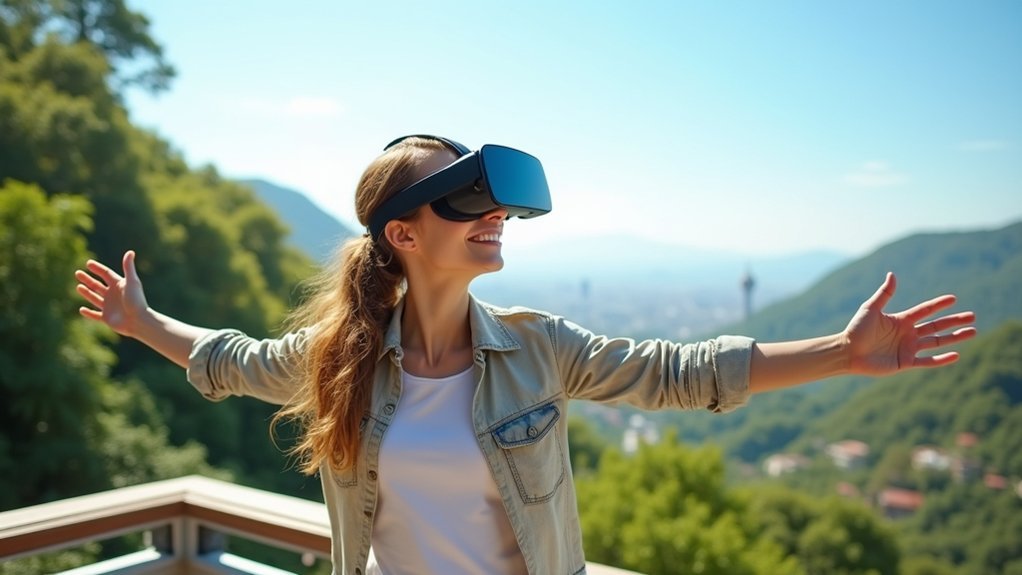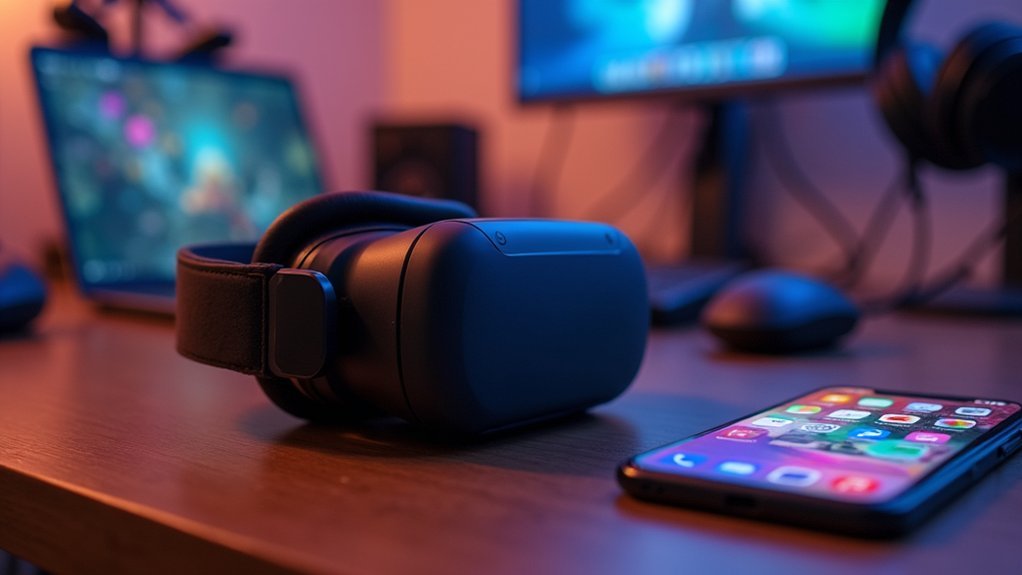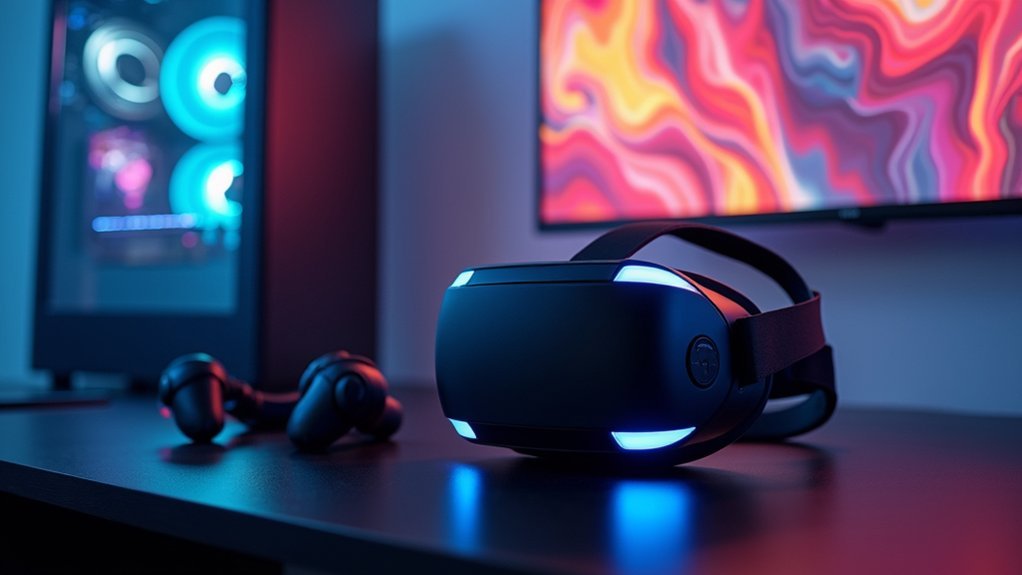You’ll find mobile VR headsets offer unmatched freedom of movement without cables or external sensors, making them perfect for any environment. They’re considerably more cost-effective, ranging from $15-400 compared to expensive tethered systems requiring powerful gaming PCs. You’ll enjoy quick setup in minutes with built-in tracking and user-friendly interfaces designed for beginners. While performance may be slightly lower than tethered options, mobile headsets provide expanding content libraries and seamless scalability. This guide explores these advantages in greater detail.
Portability and Freedom of Movement

When choosing between mobile and tethered VR headsets, you’ll immediately notice the stark difference in portability and freedom of movement.
Mobile VR headsets operate independently without requiring powerful gaming PCs, letting you transport and set them up anywhere effortlessly. You won’t deal with tangled cables that restrict your movements since these devices are completely wireless.
Mobile VR headsets deliver complete wireless freedom, operating independently without powerful PCs or restrictive cables that limit your movement.
Their lightweight design guarantees comfort during extended sessions, while built-in gyroscopes track your head movements without external sensors. This eliminates complex setup procedures you’d face with tethered systems.
The outward-facing cameras provide environment tracking, reducing spatial constraints considerably. You can move freely in your space without worrying about designated play areas or cable management that typically hampers tethered headsets.
Cost-Effectiveness and Budget Considerations
You’ll find mobile VR headsets considerably cheaper than their tethered counterparts, with prices ranging from just $15 for basic options like Google Cardboard to $400 for premium standalone devices like the Oculus Quest.
Unlike tethered systems that demand powerful computers costing thousands of dollars, mobile VR eliminates this major expense since it runs independently on smartphones or built-in processors.
This means you’re avoiding substantial hidden costs while still accessing quality VR experiences that can transform your business operations without breaking your budget.
Lower Hardware Investment
One of mobile VR’s most compelling advantages lies in its dramatically lower upfront costs compared to tethered alternatives.
You’ll find that mobile VR headsets start at just $15 for basic options like Google Cardboard, while tethered systems begin around $300 and often exceed $1,000.
Your lower hardware investment extends beyond the headset itself:
- No expensive gaming PC required – Standalone headsets like Meta Quest 2 deliver complete mobile VR experiences.
- Zero external sensors needed – Everything’s built into the device.
- Minimal hidden costs – You won’t need high-end accessories or additional gaming systems.
- Reduced total investment – Less equipment means lower overall expenses.
You’ll save considerably on hardware while still providing effective training and immersive experiences for your organization.
No PC Required
While tethered VR systems demand powerful gaming PCs that cost $1,000 or more, mobile VR headsets like the Meta Quest 2 eliminate this expensive requirement entirely.
You’ll find that no pc required means significant cost savings for your organization, as standalone headsets operate independently at a fraction of the price—typically $300 to $400 compared to tethered systems exceeding $1,000.
This independence doesn’t just offer lower cost; it also helps simplify setup dramatically.
You won’t need additional cables or external sensors that create hidden expenses with tethered solutions.
Your business can leverage this accessibility to experiment with immersive technology without the financial burden of complex systems, making mobile VR an ideal entry point for organizations exploring virtual reality capabilities.
Reduced Hidden Costs
Beyond the upfront savings, mobile VR headsets eliminate numerous hidden expenses that can double or triple your total investment in tethered systems.
When you choose mobile VR over tethered headsets, you’re avoiding these budget-friendly advantages:
- No External PC Required – Tethered systems demand high-end computers costing $800-$2,000, while mobile options work independently.
- Built-in Tracking Technology – Mobile headsets include sensors, eliminating expenses for external sensors and cameras that tethered setups require.
- Minimal Maintenance Costs – You won’t face constant hardware upgrades needed for PC-dependent systems.
- Simplified Accessories – Reduced setup complexity means fewer cables, mounts, and additional equipment purchases.
These hidden costs quickly accumulate with tethered headsets, making mobile VR the smarter financial choice for most users.
Simplified Setup and User Experience
Why struggle with complex installations when you can dive straight into virtual reality? Mobile options eliminate the technical barriers that make tethered headsets intimidating for newcomers. You won’t need external sensors, cameras, or powerful PCs – just insert your smartphone and you’re ready to explore.
The setup process takes minutes instead of hours, while tethered alternatives require multiple configuration steps and cable management. Your freedom of movement improves dramatically without wires restricting your experience.
Built-in gyroscopes and tracking sensors handle all positioning automatically, so you can set up anywhere without worrying about room configuration. Mobile headsets like the Oculus Quest feature user-friendly interfaces designed specifically for VR beginners.
This simplified setup means you’ll spend more time enjoying virtual worlds and less time troubleshooting technical issues.
Hardware Requirements and Compatibility

Since mobile VR headsets work with smartphones you already own, you’ll avoid the expensive hardware investments that tethered systems demand.
Mobile headsets offer superior compatibility across devices, while tethered headsets lock you into specific hardware requirements that can cost hundreds or thousands of dollars.
Key hardware differences include:
- Processing power – Mobile headsets use your smartphone’s built-in capabilities, while tethered headsets require VR-ready PCs with high-performance CPUs and 90Hz minimum refresh rates.
- Tracking systems – Mobile headsets rely on built-in gyroscopes, eliminating the external sensors that tethered headsets need for movement tracking.
- Setup complexity – Mobile headsets work immediately, while tethered systems require complex configurations.
- Cost barriers – Mobile headsets start at $15, making your VR experience accessible without breaking the bank.
Accessibility for New VR Users
These cost advantages and simplified hardware requirements directly translate into a more welcoming experience for VR newcomers.
When you’re stepping into VR technology for the first time, mobile experience eliminates intimidating setup processes that often discourage beginners. You won’t need extensive technical knowledge or expensive gaming PCs—just grab a smartphone or standalone VR device and you’re ready.
The wireless design creates exceptional accessibility for new users by removing claustrophobic cable constraints.
You’ll feel more comfortable exploring virtual worlds without worrying about tripping over wires or bumping into sensors. Built-in motion tracking delivers a user-friendly experience that responds naturally to your movements.
Mobile VR’s portability lets you discover virtual reality anywhere, making your introduction spontaneous and enjoyable rather than confined to dedicated gaming spaces.
Business and Professional Applications

When you’re running a business that needs VR capabilities, mobile headsets deliver significant cost savings by eliminating expensive PC requirements that can strain budgets.
Unlike tethered VR headsets, your mobile device becomes an all-in-one solution that transforms how you present to clients.
Here’s why mobile VR excels in professional settings:
- Portable presentations – You can showcase VR experiences anywhere without being confined to specific locations.
- Simplified setup – Built-in tracking eliminates external sensors and complex installations.
- Client accessibility – User-friendly interfaces make technology approachable for VR newcomers.
- Enhanced engagement – Immersive environments captivate clients while maintaining comfort through intuitive controls.
Mobile headsets remove technical barriers that often intimidate clients, creating seamless demonstrations that focus on your content rather than complicated technology.
Space Requirements and Environmental Flexibility
While tethered headsets demand dedicated rooms with carefully measured boundaries and sensor placement, mobile VR headsets adapt to virtually any environment you encounter.
You’ll discover that space requirements shrink dramatically when you choose mobile over tethered systems. Built-in gyroscopes eliminate external sensors, while outward-facing cameras handle environmental tracking automatically.
This environmental flexibility transforms how you approach VR presentations. You can deliver spontaneous presentations in conference rooms, client offices, or trade show booths without worrying about setup constraints.
Mobile VR headsets free you from cables and PC connections, letting you move naturally within available space. Their compact design means you’ll transport them effortlessly between venues, turning any location into your VR workspace without the territorial demands of tethered systems.
Battery Life and Usage Duration
Mobile VR headsets typically deliver 2-3 hours of continuous battery life, which creates both opportunities and limitations for your VR sessions.
Unlike tethered systems requiring constant PC connections, mobile headsets free you from power cords while operating independently.
Your usage duration depends on several factors that you can control:
Battery performance varies based on controllable factors like brightness, app complexity, and background processes you actively manage.
- Screen brightness settings – Lower brightness extends battery performance considerably
- VR experience complexity – Simple applications consume less power than graphics-intensive games
- Refresh rate adjustments – Reducing refresh rates conserves energy effectively
- Background process management – Limiting unnecessary apps maximizes available power
You can optimize battery life through smart settings management, potentially exceeding standard limits.
Many mobile headsets feature swappable rechargeable batteries, letting you extend sessions with backup power sources for uninterrupted immersive experiences.
Content Library and App Availability
Since mobile VR headsets operate independently, they’ve cultivated an expansive content library that rivals traditional gaming platforms. You’ll discover hundreds of applications specifically designed for standalone experiences, including popular titles like Beat Saber and VRChat available through platforms like Meta Quest Store.
The app availability for mobile VR headsets continues expanding rapidly, giving you access to diverse entertainment options.
You’re not limited to VR-specific content either. Mobile headsets can utilize existing smartphone apps, broadening your available experiences considerably.
Cross-platform compatibility enables access to content from various ecosystems, maximizing your options. Developers increasingly focus on mobile VR, creating innovative applications that cater to broader audiences rather than niche markets typical of tethered headsets.
This growing ecosystem guarantees you’ll find engaging content regardless of your interests.
Maintenance and Technical Support
Because mobile VR headsets don’t depend on external PCs or complex multi-component setups, you’ll find they require considerably less maintenance than their tethered counterparts.
The streamlined technology means you’ll encounter fewer technical issues and enjoy a more seamless experience.
Here’s what makes mobile VR headsets superior for maintenance:
- Automatic firmware updates – Your device updates over-the-air without connecting to a PC or performing manual installations.
- Built-in customer service – Access support directly through apps or online platforms, like with the Oculus Quest series.
- Simplified troubleshooting – Fewer components mean fewer compatibility problems compared to tethered systems.
- Lower hardware requirements – You’ll avoid the complexities of ensuring your system meets specifications, reducing setup time and support needs.
Scalability for Teams and Organizations
When you’re scaling VR across your team or organization, mobile headsets offer significant cost advantages that make widespread deployment feasible.
You’ll find that purchasing standalone devices like the Meta Quest 2 at around $300 each is far more budget-friendly than investing in tethered systems that exceed $800 plus the required high-end PCs.
This cost-effective approach also simplifies your IT management since you won’t need to maintain complex hardware setups or guarantee compatibility across multiple computer systems.
Cost-Effective Team Deployment
While tethered headsets demand substantial upfront investments that can quickly balloon beyond organizational budgets, mobile VR headsets offer a dramatically more accessible entry point for team deployment.
You’ll find mobile headsets ranging from $9 to $200, while tethered systems start at $300 and exceed $1000.
Here’s why mobile VR delivers superior cost-effective scalability:
- Eliminate PC requirements – You won’t need expensive high-powered computers for each headset.
- Enable quick distribution – Simple smartphone connectivity allows rapid team-wide deployment.
- Reduce setup complexity – Your team members can onboard faster without technical expertise.
- Maximize location flexibility – You can deploy VR experiences anywhere without cable constraints.
This scalability advantage means you can outfit entire teams with mobile headsets for the cost of just a few tethered systems.
Simplified IT Management
Beyond the initial cost savings, mobile VR headsets transform your organization’s IT management burden by eliminating the complex infrastructure requirements that make tethered systems a logistical nightmare.
You’ll skip the expensive PCs, external sensors, and tangled cables that tethered headsets demand. Mobile VR headsets arrive with built-in tracking and sensors, creating a truly plug-and-play experience that scales effortlessly across your team.
Your IT management becomes remarkably streamlined when employees can independently set up and operate mobile devices without technical support.
Training and onboarding processes accelerate since users don’t need to navigate complicated hardware configurations. You can distribute mobile headsets organization-wide without extensive infrastructure planning, allowing your IT resources to focus on core business operations rather than maintaining VR-specific hardware setups.
Performance Trade-offs and Quality Expectations
Although mobile headsets offer unmatched convenience, they can’t escape the fundamental trade-offs that come with cramming VR technology into a standalone device.
Mobile VR prioritizes portability over performance, creating unavoidable compromises when fitting cutting-edge technology into compact, wireless devices.
When you’re choosing between mobile and tethered options, you’ll need to adjust your performance expectations accordingly.
Here’s what you should expect when comparing mobile versus tethered headset capabilities:
- Resolution differences – Your mobile headset like the Meta Quest 2 delivers 1832×1920 pixels per eye, while tethered options provide varying resolutions that impact visual clarity.
- Graphics limitations – You’ll experience lower graphics quality due to mobile processors like the Snapdragon XR2 versus high-end PC power.
- Refresh rate variations – Your experience may feel less fluid at 72-90Hz compared to tethered headsets reaching 144Hz.
- Tracking restrictions – You’ll have fewer advanced motion tracking features available.
Frequently Asked Questions
What Is a Benefit of Untethered Headsets?
You’ll enjoy greater mobility and freedom since untethered headsets don’t require cables or external equipment. You can move around safely without tripping risks while experiencing immersive VR anywhere you want.
What Is a Benefit of Using a Tethered Virtual Reality VR Headset?
You’ll experience superior graphics quality with higher resolution displays and enhanced processing power that runs complex VR applications and games that mobile headsets can’t handle effectively.
What Is the Best VR Headset That Doesn’t Need a Phone?
You’ll find the VIVE Focus 3 offers the best standalone VR experience without needing a phone, featuring 2448×2448 pixels per eye resolution and 120-degree field of view for exceptional clarity.
What Is the Primary Difference Between a Tethered Virtual Reality Headset and a Standalone Virtual Reality VR Headset?
You’ll find tethered VR headsets need a powerful PC connection for operation, while standalone headsets work independently. Tethered systems offer superior graphics but limit movement, whereas standalone headsets provide complete wireless freedom and portability.





Leave a Reply